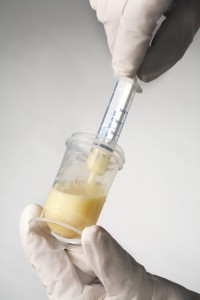March 26, 2011
Breastfeeding: The First Few Weeks of Life
By: Edith Kernerman | 0 Comments
Colostrum We know that a mother produces colostrum in pregnancy and continues to do so for up to 10 days or so after her baby is born. We know that newborn babies require nothing other than colostrum and that though it is not there in plentiful amounts it is adequate for baby's growth and health[1]. Yet, how often do we hear that a mother must begin expressing her milk because she probably won't have enough? We know that a baby who is well latched with an asymmetric latch will get the colostrum that is there, and a poorly latched baby won't[2], and yet we see thousands of mothers in our clinic who have been taught to latch baby symmetrically. Instead of adjusting the latch for better milk transfer mothers are being told to pump. And incidentally, colostrum does not respond well to a pump, it responds better to hand expression. And so when mothers can pump nothing, they are told they have no milk. Best to adjust the latch and use breast compressions[3] and watch for baby's drinking (don't listen, you are unlikely to hear a baby drinking at that age[4].
mothers are being told to pump. And incidentally, colostrum does not respond well to a pump, it responds better to hand expression. And so when mothers can pump nothing, they are told they have no milk. Best to adjust the latch and use breast compressions[3] and watch for baby's drinking (don't listen, you are unlikely to hear a baby drinking at that age[4].
Engorgement Contrary to popular belief engorgement is not a sign mother has a lot of milk. Engorgement is a sign things have gone wrong. And worse off, if the engorgement is severe enough it can cause depletion in mother's milk significantly on that breast, perhaps even for the breastfeeding experience of that baby. To avoid this, latch asymmetrically and deeply. Ensure baby drinks well, use breast compressions (see the video clip and info sheet at www.nbci.ca for the "how to") to ensure the milk continues to flow. Keep baby skin to skin so mother will be able to read baby's early cues and thus the necessary frequency of feeding that needs to happen (no timing how long per side or how long in between feeding, no counting sucks or drinking, no schedules[5] - just following baby's early cues and keeping baby drinking) and that will suffice. If mother does become engorged then using RPS [6],[7](Reverse Pressure Softening), developed by Jean Cotterman, will allow the baby to latch on immediately and drain the breast, see www.nbci.ca for the info sheet on engorgement. It is very important not to pump engorged breasts, nor to massage downward toward the nipple. Once baby is on, use breast compressions (which are always stationary) to keep baby drinking.
Sore Nipples We also know that a well-latched baby should not cause mother pain[8] and yet women are told around the world to put up with the pain, or grin and bear it because it is supposed to hurt. A troubling practice is one where the mother is told to unlatch baby and re-latch over and over until she gets it right - this repeated activity can cause damage to the nipple and is not only painful, mothers become so dejected by doing it. Instead, it's best to adjust the latch mother has already by ensuring the nose stays far away from the breast and keep baby drinking. Of course, if mother felt that the latch was absolutely unbearable and she could get a better one if she tried again, by all means. Mothers are also told to prepare their nipples (a completely non-evidenced informed practice!!) and to apply various creams and ointments on their nipples: petroleum jelly, lanolin-based creams, nipple balms - none has been supported by research. Some make matters worse. Again, simly by adjusting the latch the pain is dealt with - if not, there is something else going on.
[Lastly, if the above measures have failed to reduce soreness,] check for tongue tie [9],[10],[11].
[1] GamePlan for Protecting and Supporting Breastfeeding in the First 24 hours of Life and Beyond. Kernerman, E. 2010
[2] L-eat Latch and Transfer Tool, Kernerman, E. Park, E, Newman, J, Kouba, J. 2010
[3] Breast compressions info sheet, www.nbci.ca
[4] L-eat Latch and Transfer Tool, Kernerman, E. Park, E, Newman, J, Kouba, J. 2010
[5] Kent JC, Mitoulas LR, Cregan MD, et al. Volume and frequency of breastfeedings and fat content of breastmilk throughout the day. Pediatrics. 2006;117(3):e387-95
[6] Engorgement info sheet, www.nbci.ca
[7] Cotterman KJ. Reverse Pressure Softening: A Simple Tool to Prepare Areola for Easier Latching During Engorgement. J Hum Lact 2004 20: 227-237.
[8] Righard L Alade MO. Effect of delivery room routines on success of first breast-feed. The Lancet 1990; 336:1105-07
[9] www.tonguetie.net or www.tongue-tie.org
[10] Dollberg S, Botzer E, Grunis E, Mimouni FB. Immediate nipple pain relief after frenotomy in breast-fed infants with ankyloglossia: a randomized, prospective study. J Pediatr Surg. 2006; 41(9):1598-600.
[11] Geddes DT, Langton DB, Gollow I, et al. Frenulotomy for breastfeeding infants with ankyloglossia: effect on milk removal and sucking mechanism as imaged by ultrasound. Pediatrics. 2008; 122(1):e188-94
Posted by Edith Kernerman, IBCLC, NBCI
Tags
Postpartum Babies Edith Kernerman Asymmetrical Latch Breast Compression Breast Engorgement Colostrum First Weeks Of Breastfeeding How To Treat Sore Nipples Reverse Pressure Softening